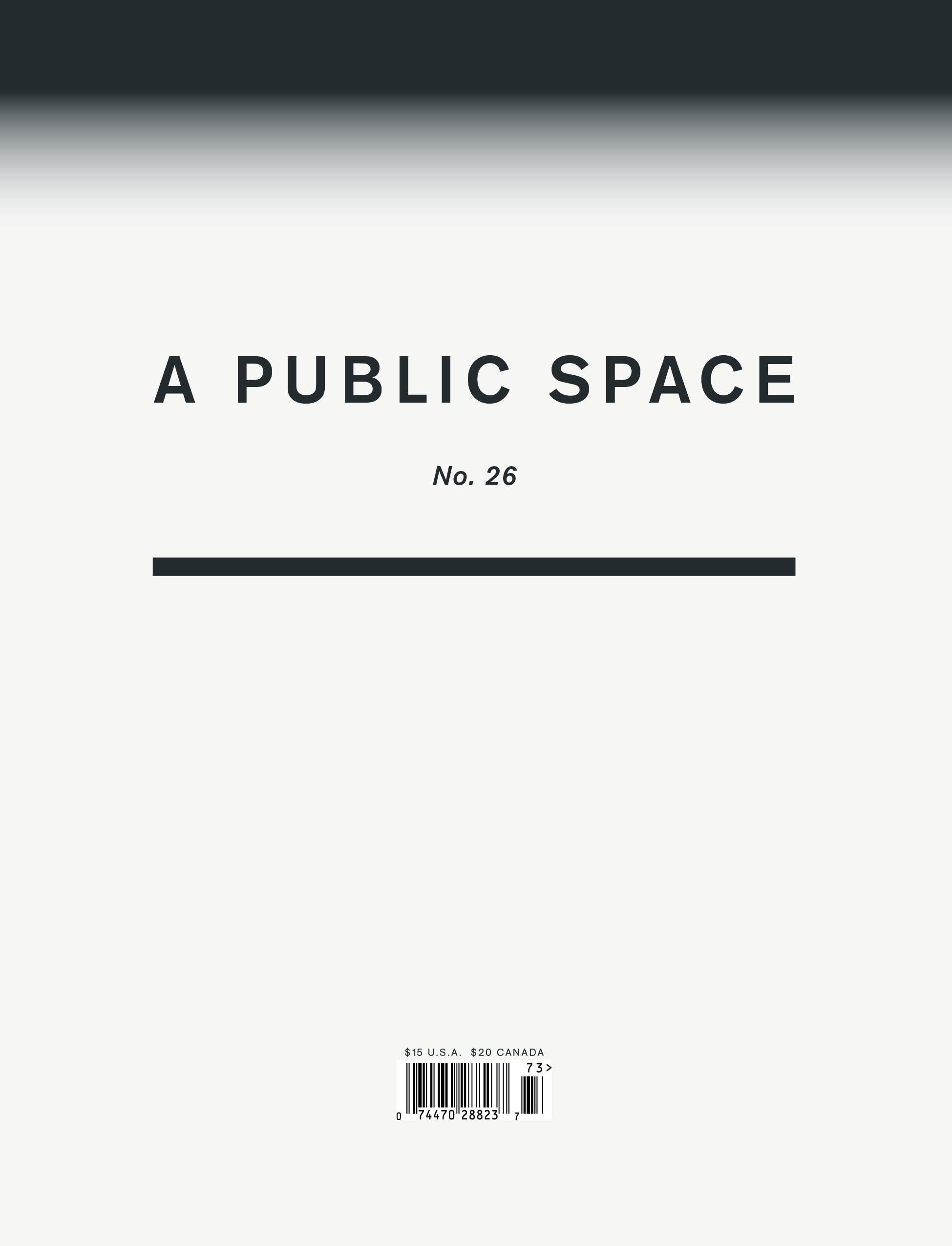A Public Space – 2017
Founded in 2006 by Brigid Hughes, A Public Space is considered one of the finest literary journals in the country; its stories frequently grace the pages of The Best American Series and The Pushcart Prize, and its editor has won the PEN/Nora Magid Award for Magazine Editing. The mission of the journal is to “seek out overlooked and unclassifiable work, and to publish writing from beyond established confines,” which it certainly meets in Issue Number 26. This current issue features a syllabus for an architecture studio, an art manifesto, the transcript of a deliberately unreadable speech by editor and writer Gordon Lish, letters to Saul Bellow, an essay on audience and performance, a proposal for a new means of displaying art in museums, notes on Main Streets across the country, and a travel journal, among the usual fiction and poetry contributions.
Founded in 2006 by Brigid Hughes, A Public Space is considered one of the finest literary journals in the country; its stories frequently grace the pages of The Best American Series and The Pushcart Prize, and its editor has won the PEN/Nora Magid Award for Magazine Editing. The mission of the journal is to “seek out overlooked and unclassifiable work, and to publish writing from beyond established confines,” which it certainly meets in Issue Number 26. This current issue features a syllabus for an architecture studio, an art manifesto, the transcript of a deliberately unreadable speech by editor and writer Gordon Lish, letters to Saul Bellow, an essay on audience and performance, a proposal for a new means of displaying art in museums, notes on Main Streets across the country, and a travel journal, among the usual fiction and poetry contributions.
While the breadth of unusual content is impressive, most pieces in this category fail to meet the artistic value of the standard fare, and several come across as disappointing gimmicks. It is vital to test the boundaries of art, to ignore rules and forge new paths, but the destination ultimately outweighs the search, and in this case the old, familiar trails provide the most satisfying journey.
By the third piece, Lea Carpenter’s “Our Experience of Being Alive and Having to Breathe,” the issue truly, fittingly comes to life. In the story, a thirty-four-year-old auctioneer, having “cured” himself of Hungary and Eastern Europe by moving west through Europe and to New York, finds himself hyping an odd collection of art—a basketball suspended in a fish tank, a crucified frog, a child-sized praying Hitler that must always be turned away from the viewer—that draws on the real-life work of Jeff Koons and Maurizio Cattelan. The auctioneer is repelled by money yet drawn to the challenge of selling. Damien Hirst floats beneath the waters of this story as well; though the central art piece is a nod to Koons, Hirst’s own famous tank installation comes to mind as the auctioneer watches blacktip sharks swimming around and under his boat. “His mother was fearless, but trapped,” Carpenter writes. “What he wanted was never to be trapped, and here he was in the open ocean, at night, unmoored.” The auctioneer ultimately learns that his night of freedom has not freed him, but he doesn’t become cynical. Instead, he is propelled forward, into the unknown.
Other contributions of note are the sad and charming letters of Bette Howland to Saul Bellow; “In a Deer Stand” by Dorthe Nors, translated from the original Danish by Misha Hoekstra; “Contract Work” by Bonnie Nadzam, in which a magical refuge from the workaday world disappears for good; Fady Joudah’s excellent poem “Epithalamion”; and “The Infinities,” by Joanna Klink, which explores what it means to live, using nature and human interaction as a sounding board. She writes:
I am unable to
picture anything so whole
it doesn’t crush what’s
missing.
Situated in the final third of the issue, “Bergtagen” by Phoebe McIlwain Bright, a 2017 A Public Space Fellow, is an impeccable story about a Norwegian family living in Oregon, struggling against winter and the chasm that is opening between father, daughter, and wife. Ingrid, the story’s protagonist, is sent to collect her father, a trapper, after their house catches fire. However, the damage runs deeper than a half-burned kitchen, and her unsavory task quickly becomes a fight for survival.
Receptiveness to a wide variety work is what makes A Public Space unique, but it is the standard categories—fiction and especially poetry—that ultimately make Issue 26 a worthy read. It is these authors who prove, time and again, that common forms can be taken to uncommon heights. Listings around the web describe the magazine’s creation as a means of “giving voice to the twenty-first century,” yet much of the unconventional content comes from the previous century, mainly from the fifties, seventies, and eighties. If the magazine wishes to channel the spirit of the post-Y2K years, it would do well to shift its focus to contemporary work, and to question whether literary merit is losing out to simple eclecticism. In her introductory note, Brigid Hughes asks, “What makes a public space? What does it encompass?” The answer, it seems, is one we’ll have to arrive at together.
[www.apublicspace.org]





